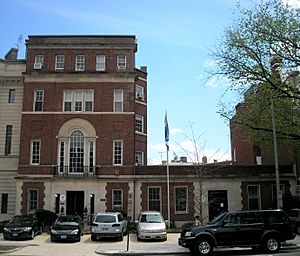Embassy facts for kids
An embassy is like a special office that one country sets up in the capital city of another country. It's where the main representative, called an ambassador, works. This office is super important because it's where most of the official talks and communication happen between the two governments. Think of it as a bridge connecting two countries!
Contents
What Do Embassies Do?
An embassy is the official place where a country's diplomatic team works in another nation. The main person in charge is called an ambassador or a high commissioner. While "embassy" often refers to the building itself, it actually means the whole group of diplomatic staff. The office part of the building where they work is called the Chancery.
The people who work at an embassy, like the ambassador, can live inside or outside the embassy building. Their homes also get special protection, just like the embassy itself.
Embassies have several key jobs:
- They represent their home country in the host country.
- They protect the interests of their country and its citizens living or visiting the host country.
- They negotiate with the host government on various issues.
- They gather information about the host country and report it back home.
- They promote friendly relations and help develop economic, cultural, and scientific ties between the two countries.
Who Works at an Embassy?
The main person at an embassy is the ambassador. They are the top representative of their country's leader to the leader of the host country.
Sometimes, a diplomatic office is headed by a lower-ranking official. In the past, these were called "legations," but that term isn't used much anymore.
A consulate is similar to an embassy but focuses more on helping individual people and businesses. Consulates are usually found in major cities outside the capital. For example, a country might have an embassy in the capital city and several consulates in other big cities to help its citizens. The person in charge of a consulate is called a consul.
If there's a disagreement between two countries, the home country might call back its ambassador. This shows they are unhappy but isn't as serious as completely cutting off diplomatic ties. In such cases, the embassy still operates, but it's led by a chargé d'affaires, who is usually the deputy (second-in-command).
Special Types of Missions
Most missions to the United Nations are called "permanent missions." For countries in the European Union, their missions to the EU are called "permanent representations."
Some countries have unique names for their missions:
- The Holy See (Vatican) sends a "nuncio" (which means "envoy" in Latin), and their mission is called an "apostolic nunciature."
- In the past, Libya's missions were called "people's bureaus."
Commonwealth High Commissions
Countries that are part of the Commonwealth of Nations (like Canada, Australia, India, and the UK) call their missions "high commissions" instead of embassies. Their leaders are called "high commissioners." This is because Commonwealth countries traditionally see each other as part of a special family, not entirely "foreign."
Even if two Commonwealth countries have different leaders (like a President and a King), their top diplomat is still called a high commissioner.
It's common for a Commonwealth country's embassy in a non-Commonwealth country to help citizens from other Commonwealth nations if their own country doesn't have an embassy there. For example, if a Canadian citizen needs help in a country where Canada doesn't have an embassy, they might go to the British or Australian embassy for assistance. The same kind of help is also offered among European Union member states.
The rules and protections for diplomatic missions, like diplomatic immunity (which means diplomats can't be arrested or prosecuted in the host country for official actions), are written down in an international agreement called the Vienna Convention on Diplomatic Relations.
Diplomatic Mission Protection
Many people think embassies are like a piece of the home country's land, but that's not quite true. Embassy buildings are usually still part of the host country's territory. However, they get very special treatment and protection under the Vienna Convention on Diplomatic Relations.
The host country cannot enter an embassy building without permission from the home country, even to put out a fire! This special protection means that an attack on an embassy is seen as an attack on the country it represents.
Because of this protection, embassies are sometimes used as a safe place by refugees. For example, people escaping from their own country might seek safety inside a foreign embassy. Once inside, diplomats can help them find a way to go to another country safely. There have been famous cases where people found refuge in embassies, like during the Iran hostage crisis (1979–1981) or the Japanese embassy hostage crisis in Lima, Peru (1996).
Multiple Missions in One City
Some cities might have more than one mission from the same country. For instance, in Rome, many countries have one embassy for Italy and another separate mission for the Holy See (Vatican City). These missions usually have different buildings and different staff.
Images for kids
-
Spanish embassy to the Holy See and the Sovereign Military Order of Malta in Rome
-
Norwegian embassy to the United States, in Washington D.C.
See also
 In Spanish: Misión diplomática para niños
In Spanish: Misión diplomática para niños









